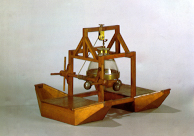
28.9 x 34.8 x 40.1
Wood, glass, brass and lead
CAT. 1824 : A.II.6
Um modelo do apparelho, com que os mergulhadores vão ao fundo do mar buscar as coisas perdidas. Consta d'um hemispherio de vidro, firmado em dous pequenos barcos, com um sarilho para o fazer subir e descer: dentro do hemispherio fica contido o ar, que os mergulhadores vem respirar de quando em quando. Chama-se em Francez Cloche du plongeur.
A model of the apparatus with which divers go to the bottom of the sea to look for lost things. It consists of a glass hemisphere, secured to two little boats, with a winch to allow it to ascend and descend. Contained inside the hemisphere remains the air that the divers come to breathe from time to time. It is called in French cloche du plongeur.
This model consists of a little glass bell jar with a brass ring around its lower part. Six lead spheres are suspended from this ring, which serve to guarantee its descent into the water. The bell is raised or lowered by a suspension cord that passes through a pulley installed on a horizontal crossbeam, which is part of a wooden structure mounted over two parallel barges. As the two barges are fixed immovably in the wooden framework, they always maintain the same position relative to each other when floating on the water.
There is a winch mounted between two vertical columns, alongside one of the two barges, where the suspension cord for the bell is wound. This winch is worked by two sets of four arms, in the shape of a cross, mounted at their ends. In order to keep the bell at rest at a given depth, there is an articulated bolt on one of the columns on which one of the command arms of the winch leans, preventing its rotation.
When submerged, the interior of the bell jar maintains sufficient air for the survival of the divers. As Desaguliers suggests in engraving XX of his work A Course of Experimental Philosophy, the divers would be protected by a system of tubes that kept them in contact with the air inside the bell, thereby enabling them to leave it to carry out their work under water.
Desaguliers, Jean-Théophile, A Course of Experimental Philosophy , London, 1744, Vol. II, Pl. XX, Fig. 7 8.